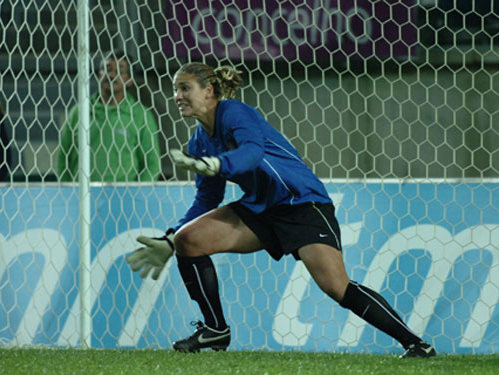SANFORD, N.C. - Welcome to Tobacco Road Golf Club. If you want vanilla, this ain't the place. If you want "same" or "tame", well, it ain't the place for that, either.
If you want a visual masterpiece and a golf course like nothing you've ever seen, then Tobacco Road will be well worth the short detour on your way to Pinehurst.
The late course architect / golf rebel Mike Strantz took a piece of sand and scrub-strewn land in central North Carolina and carved out a radical version of the considerably stuffier Pine Valley. As with many of his designs, Strantz didn't think in terms of "why" but rather "why not?"
For example, most course designers believe in a gentle introduction, especially for public-access courses where you don't want train wrecks right off the bat.
Not so here.
Hole No. 1 is a par-5 that gets in your head right away, with a pair of skyscraper mounds that frame a frighteningly narrow keyhole to the fairway. But playing from the correct tees, a solid drive can sail easily over the virtual goal-posts and land safely in a widened fairway 230 yards away.
This theme repeats itself over and over at Tobacco Road: "Perceived peril, but with manageable challenges." Strantz loves to mess with your head at Tobacco Road, keep you on your heels, and sometimes make you mutter: "Is this even fair?"
In my opinion, the layout is imminently fair when taken as a whole. While there are holes where "X" is always in play, there are an equal amount of holes which can yield easy birdies with well-played shots.
Aside from the opening salvo on No. 1, you'll most likely remember two other features -- the ravenously deep and expansive waste bunker that guards the 11th green, and the berm-encased 13th green.
The 11th features an absurdly wide fairway, which might lull you to sleep a bit. But the real fun begins on your second shot. Do you really want to challenge the green with a long iron or fairway wood? Have you contemplated the result of failure, which is a bunker shot, from inconsistent sand, where you are literally 30 feet below the surface of the green?
Good luck.
Are 30-foot deep waste bunkers "unfair?" Well, my playing partner got in it, and never got out. Five futile whacks that kept pelting the top bulkhead just below the green left him bruised and muttering. Of course, you can take a drop if you like, but ego says: "Hell, I can hit it out of there."
The 13th green is essentially a long, wide fortress, with two access gaps that look like demolition crews from "Saving Private Ryan" were able to blast them open so you could walk through. The hole begins with a dare, too, on a sharp dog-leg over trees from an elevated tee that practically begs you to cut off more than you should.
The flagstick on No. 13 (as well as several other holes) has an absurdly long extension to it, making it almost 20 feet tall. This is often necessary to see the top of the flag poking out above the revetments.
Blind shots? Oh yeah, they got ‘em. But, I have never been one who thinks ANY blind shot is an automatic design travesty. If you do, then stay home.
The greens were very healthy, but rather slow. I expect they keep them this way not only for turf health, but for player sanity. If they were trimmed to a brisk nine on the stimpmeter, it might just render Strantz's ambitious contours irrelevant. What good would it be if every approach shot, chip or putt slid off the slopes and rested on the lowest part of the green?
It is this aspect of Strantz's design which gives me pause when I ponder whether to call Tobacco Road "great" or just "very good." Can a layout be truly "great" when green speeds cannot -- by design -- approach 10 on the stimp? I'm not sure. On one hand, I'd love to play the place when the greens are humming. On the other hand, I may hate it if I do.
On two occasions, our group picked a remote edge of one of the roller coaster greens and played closest to the hole for $1 on putts of 75 feet. A nearly full shoulder turn, many twists and turns, and about 15 seconds later, our putts came to a rest no closer than 10 to 20 feet from the hole.
And that's part of the beauty of Tobacco Road. It's not about hitting the green; it's about hitting the right part of the green that matters. I found myself saying on more than one occasion: "Wow. Is that finger all the way over there also part of the green?"
Yep.
Rates range between a low $49 in the winter to a high of $129 on the weekends during peak spring season. Depending on how tolerant to scorching sandhill heat you are, Tobacco Road is a helluva bargain once summer sets in.
The clubhouse is exquisitely fashioned to reflect the tobacco country feel of the area, and every sign and tee marker is an offshoot of some aspect of getting your cigarettes out of the ground. From the ripper, the disc, the plow and the cultivator tees, you'll find enough golf course to fit your game.
Don't be fooled either by the relatively "light" distance of 6,554 yards from the back tees. An extra par-3 takes some yardage out of this total, plus the fact that the par-5's are all reachable distance for better players, and the other par-3's tend to challenge you with difficult greens, not brute length. A 150 slope should confirm the layout's teeth, if you still don't believe.
If someday you get the chance to play Tobacco Road, certainly take up the offer. If nothing else, you won't see anything like it, anywhere in the world.
Steve is a native Washingtonian and has worked in sports talk radio for the last 11 years. He worked at WTEM in 1993 anchoring Team Tickers before he took a full time job with national radio network One-on-One Sports.
A graduate of UC Santa Barbara, Steve has worked for WFNZ in Charlotte where his afternoon show was named "Best Radio Show." Steve continues to serve as a sports personality for WLZR in Milwaukee and does fill-in hosting for Fox Sports Radio.







